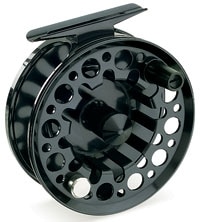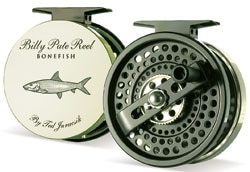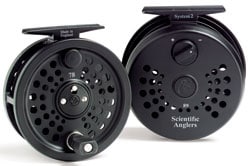
06bonefishreeel
The silver ghost of the flats: without a doubt, it’s the number-one, most-sought-after target for fly-fishermen in salt water. For years, anglers had limited choices when it came to reels with which they could arm themselves in the quest for these schizophrenic speedsters of shallow water. Today, however, with advances in reel design, construction and materials, anglers have more good choices than ever before when gearing up to chase bones.
In this first in a series of articles, we’ve broken down the options fishermen have with regard to reels. In the future, we’ll be looking at blue-water reels as well as options for anglers chasing permit, tarpon, stripers and other popular saltwater species.
As with most tackle decisions, the first and most important step is to define your target and how you’ll be chasing it. Are you going to spend 20 days a year chasing double-digit bones at Shell Key in Islamorada? Or maybe you’re sneaking away for a couple days to the Bahamas to chase smaller but less-finicky fish. Perhaps it’s even a trip to Los Roques or Christmas Island where the general size of the fish is more than compensated for by a willing attitude. Once you decide on the target, you need to determine how you’ll be fishing for them. Will you be primarily wading or fishing from a boat? Are you going to be casting to nervous, hyped-up fish in shin-deep water or casting to cruising or mudding fish in several feet of water?
Once you’ve defined those parameters, then you can get down to the nitty-gritty: things like price, retrieve mode, drag, capacity, weight and arbor size.
Price
For our purposes here, we’ve broken bonefish reel selection into three price categories: entry-level ($40-$199), mid-range ($200-$399) and premium ($400-plus). In the early days of fly-fishing in salt water, anglers had few choices other than some of the old standards like the Seamaster S-handle or Fin Nor Wedding Cake. Those were (and remain today) great reels, but nearly 50 years later – thanks to improvements in materials, design and manufacturing processes – anglers have a wider range of choices that will get the job done.
As with choosing a fly rod, it’s important that anglers buy the best reel they can

afford. The good news is that all three categories have some fantastic choices. In the under-$200 category, Echo, Nautilus, Okuma, Orvis and Sage offer some great options. In the mid-range category, these manufacturers are joined by Albright, Alutecnos, Bauer, St. Croix and Waterworks-Lamson. In the premium-reel category come the big boys, including Abel, Hardy, Pate, Tibor, Van Staal and others offering some great high-end equipment that’s sure to be handed down over generations.
Direct Drive, Anti-Reverse or Dual Mode?
Once you’ve determined the amount of money you want to spend, the next question is what retrieve mode is best for you. There are three types: direct-drive, anti-reverse and dual mode (a combination of the first two).
Direct-drive mode is probably the most popular and, consequently, anglers have the most variety to choose from in this category. When the drag is engaged on a direct-drive reel, the spool and handle turn as the fish runs, a characteristic that has earned these reels the nickname “knucklebusters” through the years.
Anti-reverse-mode reels like the Billy Pate utilize a slip clutch that allows the handle to remain stationary while the fish takes line. Their two biggest advantages are bloodless knuckles and fewer broken tippets on speedy runs when koala-like reflexes such as mine aren’t up to par.
The dual-mode reel first popularized by the late Capt. Bob McChristian of Seamaster fame gives anglers the best of both worlds. If an angler wants direct-drive-type control, all he needs to do is wind. If he wants to back off and allow the fish to run without busting his fingers, slightly pulling back the handle allows a slip clutch to engage. One of the newest entrants into the dual-mode market is the Marryat Plus, which uses a unique finger-pressure system on the handle to switch from direct drive to anti-reverse.
I prefer direct-drive reels for most of my personal fishing. Bonefishing, though, is one of the areas where anti-reverse or dual-mode reels can come into their own. They’ll help prevent busted knuckles and parted tippets for novice or beginning anglers.
**

Drag**
For most of the history of our sport, cork has been the gold standard by which all other drag materials have been judged. Since the advent of the Penn International Fly Reel (developed by then-owner Betty Henze) in the early 1990s, synthetic or composite drag materials have come into their own. Cork remains an incredibly durable, reliable material and is the basis for a number of premium reels like the Abel, Pate and Tibor. Some other manufacturers like Orvis, Bauer and Echo opt for composite or composite-natural combination drags.
Two other interesting options include felt and the unique conical-drag system preferred by Waterworks-Lamson. Felt and cork are the basis for the drag in the Tibor Back Country Wide and offer a smooth, easy, low-maintenance alternative to other materials. Originally designed to work as a freshwater reel, the BC Wide has earned a fast following for anglers chasing tailing fish on foot, a situation where lighter outfits are definitely favored. The smooth, virtually zero-resistance startup offered by the felt has also made it popular for anglers chasing bonefish on light tippets.
With regard to the conical-drag system, I haven’t had enough experience with it to render an opinion, but it is an interesting concept that I think will have a place for those chasing these silvery shadows across the flats.
Capacity
In the early days of bonefishing, anglers were advised that they needed a minimum of 300 yards of backing to accommodate routine runs exceeding 200 yards. I’ve never personally seen a bonefish make a run of more than 100 yards (having caught them to 10 1/2 pounds). Although I could be proven wrong, today’s anglers are fine with reels holding a full WF-F floating fly line and 200 yards of 20-pound Dacron backing. That’s a good general standard.
Even on a reel that holds that much line, it is possible (and this is something I do on all my outfits) to bump that capacity up by as much as 40 percent by using gelspun backing. If you do that, the only way you’ll ever risk getting spooled by a bonefish is if a 400-pound bull shark eats it. Another option allowing for even more backing is to trim several yards of running line off the back end of your fly line.
Weight
One of the most important considerations when determining what type of fishing you’ll be doing is weight. My personal favorite fly-fishing scenario is chasing tailing bonefish on foot. In that situation – as opposed to fishing in a skiff – every ounce counts. This is where ported reels like the BC Wide, Nautilus Featherweight or Abel Super Series really come into their own, offering strong, lightweight reels that are up to the task while keeping the overall weight of the outfit you’ll be toting and casting all day to a minimum. If taking your shots from the bow of a skiff, more substantial (read heavier) reels are fine.
**

Standard, Mid-sized or Large Arbor**
Without a doubt, mid- and large-arbor reels are among the most popular styles with just about every segment of fly-fishers chasing targets in brine. While standard-arbor reels like Pate’s Salmon or Bonefish or the Abel #2 Big Game are great bonefish reels, mid- and large-arbor reels offer several distinct advantages.
First, the larger outside diameter allows for faster line recovery, something you’ll appreciate when a big bone decides to change direction and start zipping back toward the boat at warp factor 6. The larger diameter also stores your fly line in larger coils on the spool, alleviating some problems with line memory.
Most of the modern large-arbor designs are ported or vented spools similar to the Abel Super Series or Tibor Everglades. This not only lightens the reel, but also allows backing to dry and makes it possible to get most of the salt out of your reel when hosing it off at the end of the day.
Another consideration is whether to go with a rim-control spool or not. Most reels today feature exposed rims that allow anglers to palm to the spool, adding additional drag when needed. It all depends on your style of fighting fish.
Bottom Line
Selecting a bonefish reel is a very personal choice. Fortunately, today’s bonefishermen have more choices than ever, and there are few – if any – substandard options in the field. Whether you want to get into an entry-level reel to catch your first Bahamian bone, or if you’re looking for a high-end, machined, anodized large-arbor reel to chase monster bones in Downtown Islamorada, chances are there’s a perfect reel for you. But don’t take my word for it; these are just some of the considerations I take into account when putting together a bonefish outfit. Seek advice from your local fly-tackle dealer, your favorite fishing guide or any of the manufacturers listed here. Then you can make the reel choice.









